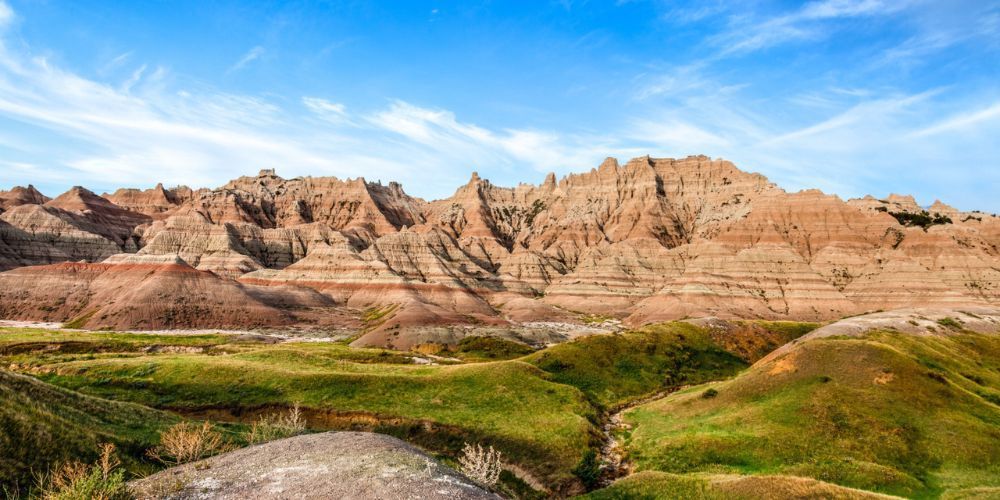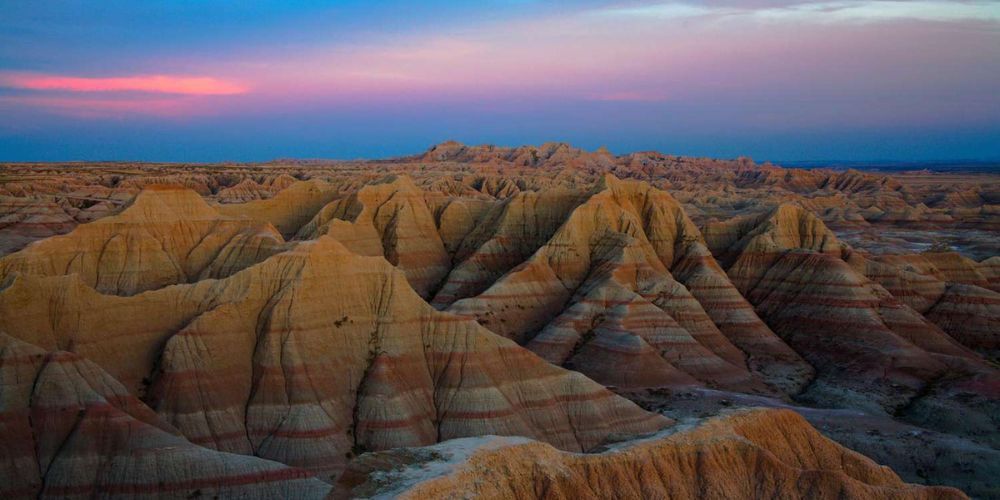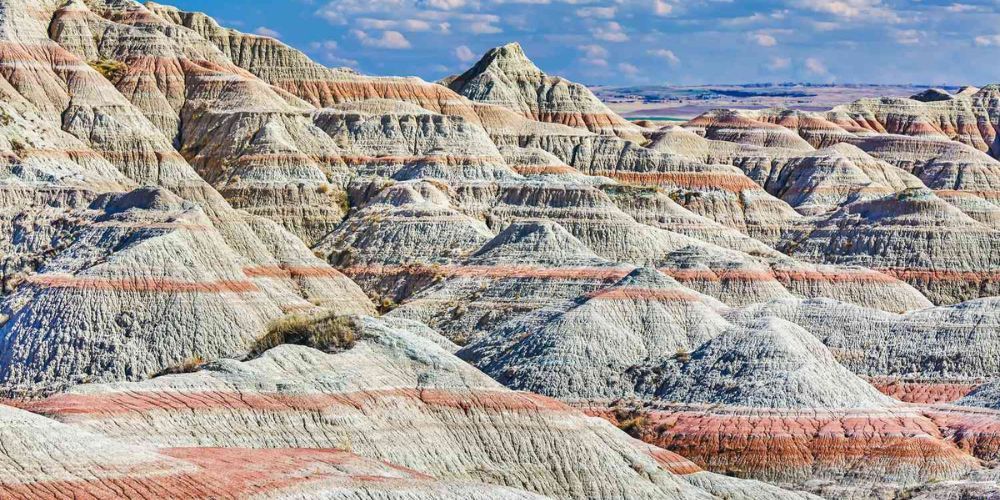Exploring the Majestic Badlands National Park: A Comprehensive Guide
July 30, 2024
Imagine stepping into a land where layers of colorful rock formations stretch as far as the eye can see and wild grasses dance in the breeze under an endless sky. This is Badlands National Park—a place where nature's artistry meets untamed wilderness, offering unparalleled hiking trails and stunning photo opportunities. For those who seek beauty beyond the ordinary landscapes, this is a haven waiting to be explored at sunrise, when the pinnacles glow with hues of pink and gold.
Planning your visit requires careful preparation to truly grasp all that Badlands has to offer. We’ve done extensive research to provide you with accurate information on everything from scenic drives to hidden trailheads known only by experienced hikers. Unexpectedly, you'll discover how this park intertwines with rich cultural narratives as it is co-managed with the Oglala Lakota tribe—adding another layer of depth to your adventure. Now, let's dive into understanding why this extraordinary terrain calls out to wanderers and explorers alike.
The must-see attractions in Badlands National Park include the Badlands Loop Road for scenic drives, the Fossil Exhibit Trail for fossil viewing, and the Door Trail for incredible rock formations. Additionally, don't miss the Ben Reifel Visitor Center to learn about the park's natural and cultural history.

Visiting Badlands National Park
As you prepare for your expedition to Badlands National Park, it's essential to understand that this otherworldly destination offers a diverse range of experiences, from scenic drives and hiking trails to wildlife observation. The park's distinctive features are spread across the North and South Units, each with its own unique characteristics that beckon adventurers seeking awe-inspiring views.
The North Unit is the more frequented area of the park, with well-developed trails and overlooks that provide breathtaking panoramic vistas of the rugged badlands formations. As you traverse the North Unit, you'll encounter iconic landmarks such as "Yellow Mounds," displaying vibrant hues of yellow and gold, and "Big Badlands Overlook," offering sweeping views of the rock formations against the expansive horizon. The easily accessible boardwalks and trails in this section make it an ideal choice for both seasoned hikers and families looking for a leisurely stroll.
On the other hand, the South Unit, co-managed with the Oglala Lakota tribe, presents a more remote and wild terrain, inviting visitors to immerse themselves in the untamed beauty of the badlands. This portion of the park boasts fewer developed trails and overlooks, creating an opportunity for those seeking a more rugged, off-the-beaten-path experience. The South Unit provides an authentic glimpse into the primal essence of Badlands National Park, with its undisturbed landscapes and secluded expanses captivating intrepid travelers.
Imagine standing atop a weathered formation in the South Unit, gazing across a vast expanse of untouched prairie land and intricate geological formations. The experience is one that leaves an indelible impression of nature’s raw magnificence. Whether you're navigating established trails or venturing into uncharted paths, the South Unit holds an allure for individuals eager to forge their own paths through unspoiled wilderness.
Exploring both units allows visitors to appreciate the full spectrum of what Badlands National Park has to offer. By understanding the distinct characteristics of each area, you can tailor your visit to align with your preferences and embark on an unforgettable journey through one of America’s most remarkable landscapes.
With a sense of wonder instilled by the captivating features of Badlands National Park, it's time to unravel the logistics of getting there and navigating this grand natural haven.
Getting There and Around
One of the most convenient ways to reach Badlands National Park is by car. If you're traveling from Rapid City, which is the closest major city, the park lies approximately 75 miles to the east. The primary access roads leading to the park are Interstate 90 and South Dakota Highway 44. These well-maintained highways offer a smooth and scenic journey that sets the stage for the unique landscape awaiting you at your destination.
For those who don't have access to a personal vehicle, Rapid City Regional Airport serves as a gateway to the region. However, it’s important to note that shuttle services to the park are limited from the airport. In such cases, rental cars become a go-to choice for visitors looking to explore the park at their own pace.
Insider Tip: Consider booking your rental car in advance, especially during peak tourist seasons, to secure your preferred vehicle type and avoid any last-minute inconvenience.
Once inside the park, an array of well-maintained roads awaits, providing easy access to its key attractions and scenic vistas.
Navigating Park Roads
Immerse yourself in the awe-inspiring beauty of Badlands National Park by embarking on a journey along its picturesque drives. The renowned Badlands Loop Road, also known as Highway 240, offers an unmissable opportunity to marvel at panoramic landscapes with numerous pullouts and overlooks for capturing stunning photographs.
The iconic Highway 240 isn’t just a means of transportation; it’s an experience in itself. Picture-perfect moments present themselves at every turn, urging you to pause and absorb the majestic views around you.
As you plan your visit to Badlands National Park, remember that each mode of transport offers its own advantages – from the freedom of navigating park roads by car to embracing the convenience of rental services or shuttle options. With these insights, you can now confidently chart your course for an unforgettable adventure amidst the raw natural beauty of Badlands National Park.
With a clearer picture of how to navigate through Badlands National Park, it's time to uncover the captivating must-see landmarks that await your discovery.

Must-See Landmarks
As you venture into the Badlands National Park, there are several iconic landmarks that are simply unmissable. Each one tells a unique story about the park's geological and historical significance, offering visitors a chance to witness the raw beauty of this natural wonder.
The Pinnacles Overlook
From the Pinnacles Overlook, visitors are treated to breathtaking panoramic views of the rugged rock formations intertwining with the vast expanse of prairies. The intricate maze of spires and buttes creates an unforgettable scene that seems straight out of a painting, showcasing the true essence of the Badlands' unique landscape.
The Wall
Stretching over an expansive 100 miles, The Wall is an impressive escarpment that serves as a grand showcase of the park's extraordinary geological features. For photographers and nature enthusiasts, The Wall offers an unrivaled backdrop for capturing striking images. Whether it's the play of light and shadows or the sheer scale of the formations, The Wall presents an endless array of mesmerizing vistas waiting to be captured and cherished.
As you stand in front of The Wall, take a moment to absorb its grandeur - it's like witnessing nature's own masterpiece unfold before your eyes.
Ben Reifel Visitor Center
Before embarking on your exploration of Badlands National Park, a visit to the Ben Reifel Visitor Center is a must. This essential first stop invites visitors to dive deeper into the park's geology, paleontology, and history through engaging educational exhibits. The center not only serves as a gateway to understanding the park but also provides valuable resources such as a theater, bookshop, and an information desk offering insightful advice for exploring the area.
Imagine immersing yourself in real fossils, interactive displays, and vivid representations of the park’s evolution over millions of years. It's an enlightening experience that enriches your understanding and appreciation of the Badlands' deep-rooted natural heritage.
These landmarks are more than just points on a map; they are gateways to profound natural wonders and human history that await your exploration.
As you step into the rugged yet enchanting realm of Badlands National Park, prepare yourself to encounter fascinating wildlife thriving in their natural habitat.

Wildlife and Habitats
Badlands National Park isn't just known for its awe-inspiring rock formations and iconic landscapes; it's also home to a diverse array of wildlife. From the mighty bison and elusive black-footed ferrets to prairie dogs and the graceful pronghorn, there's an abundance of fascinating creatures to be found amidst the striking beauty of the park.
The bison, with their massive frames and impressive horns, are often a star attraction. These iconic animals can often be spotted grazing across the sprawling grasslands or wandering leisurely within the canyons, offering nature enthusiasts a remarkable sight that harkens back to the ancient times when these majestic beasts roamed freely across the American plains.
It's not just about what you see either. The sounds of nature fill the air, from the haunting calls of birds echoing through the canyons to the scurrying sounds of small mammals in the underbrush.
One of the most enriching experiences for visitors is observing wildlife in their natural habitats. The park's mixed-grass prairies, canyons, and river valleys provide a diverse range of ecosystems where various species thrive. This ecological diversity offers a rare glimpse into the interconnected web of life in this expansive wilderness.
Visitors who are eager to catch a sight of these fascinating animals should plan their wildlife watching at specific times - dawn or dusk. During these hours, many creatures become more active, creating prime opportunities for observing them in their natural behaviors.
For example, imagine standing on one of the park's overlooks as the sun starts to dip below the horizon, casting a warm glow over the landscape. This magical time is perfect for catching a glimpse of bison meandering through the grasslands or witnessing prairie dogs popping in and out of their burrows.
By respecting this wildlife and their habitats, visitors contribute to the conservation efforts that protect these remarkable species and preserve their natural environment for future generations to admire and appreciate. Whether it's spotting bighorn sheep scaling steep cliffs or watching bison graze against a backdrop of rugged beauty, Badlands National Park offers an exceptional opportunity for an up-close encounter with nature at its finest.
As we've ventured through the wildlife and habitats of Badlands National Park, it's time to dive into the myriad activities and attractions that await explorers within this stunning landscape.
Activities and Attractions
When it comes to things to do in Badlands National Park, you'll be spoiled for choice. Whether it's hiking through dramatic landscapes, discovering ancient fossils, or stargazing under some of the darkest skies in the country, there's something for everyone here.
Hiking
Hiking is one of the most popular activities in Badlands National Park and for good reason. The park offers a variety of trails that cater to different skill levels and interests. For those seeking an adventurous climb and breathtaking views, the Notch Trail, with its ladder climb and dramatic overlook, is a must. The Fossil Exhibit Trail is another great option, featuring interpretive signs about the park's ancient life forms, giving hikers a chance to learn as they explore.
No matter which trail you pick, you're sure to witness stunning rock formations, unique wildlife, and maybe even spot some ancient fossils along the way. Remember to wear comfortable shoes, bring plenty of water, and always check the weather conditions before embarking on your hike.
Fossil Hunting
If you have an interest in paleontology or just enjoy learning about ancient history, fossil hunting is a fascinating activity in Badlands National Park. The park is home to one of the richest fossil beds from the Oligocene epoch, and visitors have the opportunity to see these rare specimens up close. However, it's important to note that collecting fossils is strictly prohibited in the park – so remember to leave them where you found them for others to admire.
It's an awe-inspiring experience to walk among the remnants of creatures that lived millions of years ago. The park's visitor centers offer valuable information about the fossils found in the area and how they contribute to our understanding of prehistoric life.
Stargazing
For those fascinated by the night sky, Badlands National Park provides an incredible stargazing experience. Designated as a Dark Sky Park, this location offers some of the darkest skies in North America. On clear nights, visitors have the opportunity to gaze at constellations, meteor showers, and even catch a glimpse of the Milky Way. It's a serene and humbling experience that puts into perspective our place in the universe.
Imagine laying on a blanket under a sky full of stars, with only the sounds of nature surrounding you – it's an unforgettable moment that highlights the park's natural beauty beyond its striking daytime landscapes.
These activities provide a diverse range of experiences for visitors at Badlands National Park, showing that there's more than just scenic views waiting to be discovered within its borders.
In this land where time seems to stand still, the changing climate brings its own set of wonders and considerations. Next, we'll uncover the seasonal nuances and optimal times to visit this captivating landscape.
Climate and Best Times to Visit
When exploring the breathtaking Badlands National Park, it's crucial to understand its unique climate. The park's weather significantly impacts your experience, so planning your visit at the right time is essential. Badlands National Park experiences a semiarid climate with distinctive seasons that offer different experiences to visitors.
During summer, which spans from June to August, temperatures in the park soar and often exceed 100°F. This period can be quite intense, making outdoor activities challenging and less enjoyable due to the extreme heat. Moreover, sudden thunderstorms are common occurrences during this time, posing potential safety risks for visitors. In contrast, winter (December through February) brings cold temperatures and snowfall, leading to road closures and restricted access to certain areas within the park.
To make the most of your visit and avoid extreme weather conditions, consider planning your trip during the more temperate seasons of spring and fall. This encompasses the months of April to June for spring and September to November for fall.
During these seasons, you can enjoy more moderate temperatures, allowing for comfortable exploration of the park's diverse landscapes and engaging in outdoor activities without being hampered by scorching heat or freezing temperatures. Additionally, rainfall is typically minimal during these periods, offering clearer skies and enhanced visibility for enjoying the stunning natural beauty of the park.
Imagine strolling along the rugged trails flanked by vibrant wildflowers in bloom during spring or witnessing the spectacular display of autumn colors painting the landscape in warm hues during fall. These experiences perfectly capture the essence of Badlands National Park during these recommended seasons.
Furthermore, when planning your visit, it's vital to stay informed about current weather conditions and road statuses within the park. Before embarking on your journey, checking weather forecasts and road accessibility will enable you to make informed decisions and ensure a safe and enjoyable experience.
By aligning your visit with the optimal seasons and staying updated on weather conditions, you can maximize your adventure at Badlands National Park, reveling in its awe-inspiring beauty while ensuring a safe and pleasant excursion amidst its captivating landscapes.
Choosing the right time to visit Badlands National Park is fundamental to experiencing its majestic wonders while ensuring a memorable and safe adventure. I wish you an incredible journey filled with captivating moments amidst the park's breathtaking landscapes.
What are the must-see attractions in Badlands National Park?
Badlands National Park is a treasure trove of unique landscapes and attractions. Here are some must-see spots:
• Badlands Loop Road: This scenic drive is a great way to experience the park’s dramatic scenery. The 31-mile loop offers numerous overlooks where you can stop and take in panoramic views of the jagged rock formations and expansive prairies.
• Fossil Exhibit Trail: This short, accessible trail provides a glimpse into the park’s prehistoric past. Informative displays along the way highlight the fossilized remains of ancient mammals, making it both educational and fascinating for all ages.
• Notch Trail: If you’re up for a bit of adventure, the Notch Trail is a popular choice. The 1.5-mile round-trip hike involves climbing a wooden ladder and navigating a narrow ledge, leading to a breathtaking view of the White River Valley.
• Yellow Mounds Overlook: Known for its strikingly colorful mounds, this overlook is a photographer’s dream. The vibrant yellow, purple, and red hues are a result of ancient volcanic ash deposits and are best seen during sunrise or sunset.
• Sage Creek Wilderness Area: For a chance to see wildlife, head to this area of the park. Bison, bighorn sheep, and prairie dogs are commonly spotted here, offering a more rugged and less crowded experience compared to the main loop road.
What are the best hiking trails in Badlands National Park?
Badlands National Park boasts a variety of hiking trails suitable for all levels of hikers. Here are some of the best ones:
• Door Trail: This easy, 0.75-mile round-trip hike is perfect for families and those looking for a quick exploration. The trail leads through a break in the Badlands Wall to a scenic overlook, offering stunning views of the eroded landscape.
• Window Trail: Another short and easy trail, the 0.25-mile Window Trail ends at a natural “window” in the rock, providing a framed view of the Badlands. It’s a great option for a brief, yet rewarding, walk.
• Castle Trail: For those seeking a longer adventure, the Castle Trail is the longest in the park at 10 miles round trip. It traverses a variety of terrains, from open prairies to rugged badlands formations, offering diverse scenery along the way.
• Medicine Root Loop: This 4-mile loop trail connects with the Castle Trail and offers a moderate hike through mixed-grass prairie. It’s a great way to experience the park’s flora and fauna, with fewer crowds than the more popular trails.
• Saddle Pass Trail: This short but steep 0.25-mile trail is a challenging climb to a high ridge, where you’ll be rewarded with panoramic views of the Badlands. It’s a strenuous hike, but the views make it well worth the effort.
When is the best time to visit Badlands National Park?
The best time to visit Badlands National Park depends on what you hope to experience. Here are some considerations for each season:
• Spring (March to May): Spring is a fantastic time to visit if you want to see wildflowers in bloom and enjoy milder temperatures. Wildlife is also more active during this time, making it ideal for spotting animals. However, be prepared for occasional rain and muddy trails.
• Summer (June to August): Summer is the peak tourist season, with warm to hot temperatures and plenty of sunshine. It’s a great time for hiking and camping, but be ready for higher visitor numbers. Early mornings and late afternoons are the best times to explore to avoid the midday heat.
• Fall (September to November): Fall offers cooler temperatures and fewer crowds, making it a pleasant time to visit. The changing colors of the prairie grasses add a beautiful touch to the landscape. This season is also a great time for wildlife viewing, as animals prepare for winter.
• Winter (December to February): Winter visits can be serene and offer a unique perspective of the park. The landscape covered in snow is stunning, and you’ll have much of the park to yourself. However, some facilities may be closed, and the weather can be harsh, so it’s important to come prepared for cold conditions and potential road closures.
By considering these factors, you can choose the best time to visit Badlands National Park based on your interests and preferences.
Check out the latest guides on hiking gear
Author: William Flaiz










